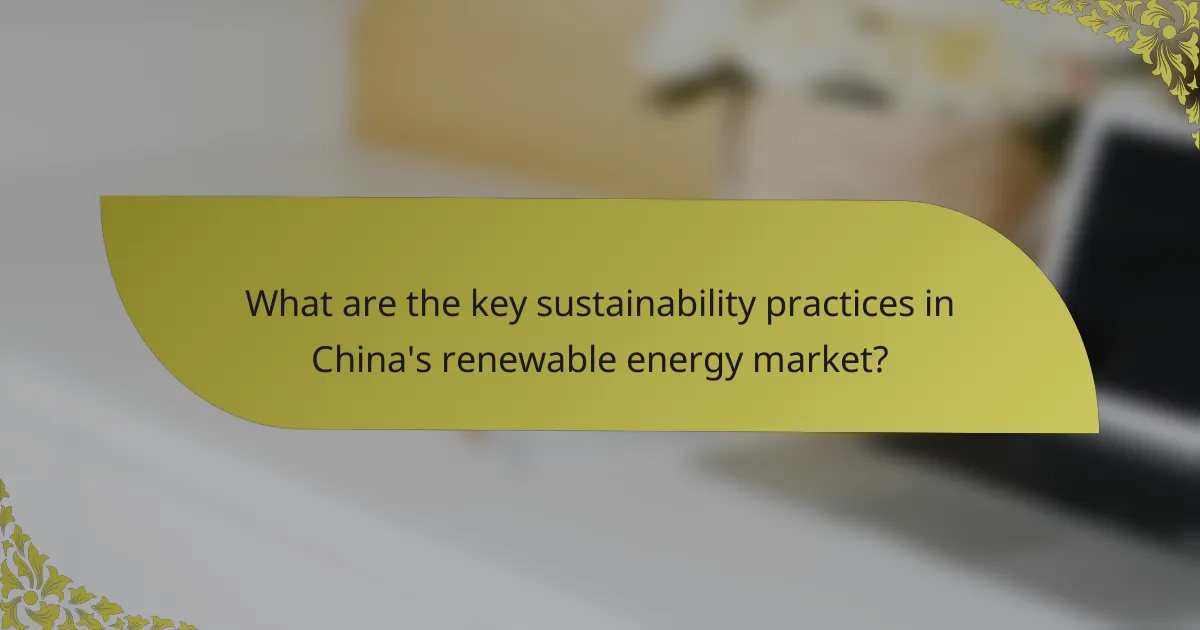The main entity of the article is China’s renewable energy market, which is characterized by key sustainability practices such as advanced technology integration, efficient resource management, and strong regulatory support. The article outlines China’s significant investment in renewable energy, exceeding $300 billion in 2021, aimed at achieving carbon neutrality by 2060. It highlights China’s leadership in solar panel production, accounting for over 70% of global output, and its substantial wind energy capacity. Additionally, the article discusses the government’s initiatives, including the “Green Energy Certification,” and the anticipated growth in renewable energy consumption, projected to surpass 50% by 2025. Overall, these elements illustrate China’s commitment to sustainability and its role as a global leader in the transition to renewable energy.

What are the key sustainability practices in China’s renewable energy market?
Key sustainability practices in China’s renewable energy market include the integration of advanced technologies, efficient resource management, and regulatory support. Advanced technologies such as solar photovoltaic systems and wind turbines are widely adopted. Efficient resource management focuses on optimizing energy generation and reducing waste. Regulatory support from the government promotes investment in renewable projects. In 2021, China invested over $300 billion in renewable energy. This investment supports the country’s goal to achieve carbon neutrality by 2060. Additionally, initiatives like the “Green Energy Certification” ensure sustainable practices in energy production. These practices collectively enhance the sustainability of China’s renewable energy sector.
How have these practices evolved over time?
Sustainability practices in China’s renewable energy market have evolved significantly over the past few decades. Initially, the focus was on basic renewable energy development, primarily wind and solar power. In the early 2000s, China began investing heavily in renewable technologies, driven by the need for energy security and environmental concerns. By 2010, China emerged as the world’s largest producer of solar panels.
Government policies played a crucial role in this evolution. The introduction of feed-in tariffs and subsidies accelerated the adoption of renewable energy sources. As a result, China’s renewable energy capacity grew from 10 gigawatts in 2000 to over 1,000 gigawatts by 2020.
In recent years, the emphasis has shifted towards innovation and technology advancement. Research and development in energy storage and smart grid technologies have become priorities. Furthermore, international collaborations are becoming more common, enhancing knowledge exchange and technology transfer.
Overall, China’s sustainability practices in renewable energy have transitioned from basic development to a comprehensive, innovation-driven approach. This shift is evidenced by the country’s leading position in global renewable energy investments and technological advancements.
What historical factors influenced the development of sustainability practices?
The development of sustainability practices has been influenced by several historical factors. Industrialization in the 19th century led to increased pollution and resource depletion. This prompted early environmental movements, advocating for conservation and responsible resource management. The 1972 United Nations Conference on the Human Environment marked a pivotal moment, raising global awareness of environmental issues. The 1987 Brundtland Report introduced the concept of sustainable development, emphasizing the need for balance between economic growth and environmental protection. Additionally, the rise of climate change awareness in the late 20th century spurred policy changes and innovations in renewable energy. China’s rapid industrial growth and subsequent environmental challenges have also shaped its approach to sustainability. These historical contexts collectively inform current sustainability practices globally and in China’s renewable energy sector.
How do government policies shape these practices?
Government policies significantly shape sustainability practices in China’s renewable energy market. These policies set regulatory frameworks that encourage investment in renewable technologies. For instance, the Renewable Energy Law of 2005 mandates grid access for renewable energy producers. This law has led to increased capacity for wind and solar energy. Additionally, the government provides financial incentives, such as feed-in tariffs, to promote renewable energy adoption. According to the National Energy Administration, China’s renewable energy capacity reached 1,000 GW in 2020, largely due to supportive policies. Furthermore, the government’s commitment to carbon neutrality by 2060 has intensified efforts in sustainable practices. Overall, policies directly influence the growth and implementation of renewable energy initiatives in China.
What types of renewable energy sources are utilized in China?
China utilizes several types of renewable energy sources. The main sources include solar energy, wind energy, hydroelectric power, and biomass. Solar energy is harnessed through extensive photovoltaic installations across the country. Wind energy is generated from numerous wind farms, particularly in coastal and northern regions. Hydroelectric power comes from large dams, such as the Three Gorges Dam, which is the world’s largest. Biomass energy is produced from agricultural waste and other organic materials. In 2021, renewable energy accounted for over 29% of China’s total energy consumption, showcasing the country’s commitment to sustainable energy practices.
What are the benefits of solar energy in China’s sustainability efforts?
Solar energy significantly contributes to China’s sustainability efforts. It reduces greenhouse gas emissions, helping combat climate change. In 2020, solar power accounted for approximately 10% of China’s total electricity generation. This shift towards renewable energy decreases reliance on coal, which has been a major pollutant. Furthermore, solar energy promotes energy security by diversifying the energy mix. The Chinese government has heavily invested in solar technology, making it a global leader in solar panel production. This investment also drives job creation in the renewable energy sector. Overall, solar energy enhances environmental quality and aligns with China’s goals for sustainable development.
How does wind energy contribute to sustainability in China?
Wind energy significantly contributes to sustainability in China by reducing reliance on fossil fuels. It helps decrease greenhouse gas emissions, which are major contributors to climate change. In 2022, wind energy accounted for approximately 10% of China’s total electricity generation. This shift supports national goals for carbon neutrality by 2060. Additionally, wind energy projects create jobs and stimulate local economies. The Chinese government has invested heavily in wind infrastructure, leading to advancements in technology and efficiency. This investment has positioned China as a global leader in wind energy capacity. Overall, wind energy enhances energy security and promotes sustainable development in China.
What are the challenges faced in implementing sustainability practices?
Implementing sustainability practices faces several challenges. One major challenge is the high initial investment required for renewable energy technologies. A report by the International Renewable Energy Agency indicates that upfront costs can deter businesses from adopting sustainable practices. Regulatory hurdles also complicate the implementation process. Complex regulations can create barriers for companies trying to transition to renewable energy sources. Additionally, there is often a lack of technical expertise in renewable technologies. Many organizations struggle to find skilled workers who can manage and maintain these systems effectively. Public awareness and acceptance of sustainability practices can also be limited. Without sufficient understanding, stakeholders may resist changes. Finally, market competition can hinder sustainability efforts. Companies may prioritize short-term profits over long-term sustainability goals.
What economic barriers hinder the growth of renewable energy?
High initial investment costs hinder the growth of renewable energy. These costs include expenses for technology, infrastructure, and installation. For example, solar panel installations require significant upfront capital. Additionally, fluctuating government policies can create uncertainty for investors. This uncertainty affects long-term financial planning and investment decisions. Limited access to financing options also poses a challenge. Many renewable energy projects struggle to secure loans or grants. Moreover, competition from fossil fuels often leads to lower prices, making renewables less attractive. According to the International Energy Agency, investment in renewable energy must increase significantly to meet global targets.
How do technological limitations impact sustainability efforts?
Technological limitations hinder sustainability efforts by restricting the efficiency and scalability of renewable energy solutions. These limitations can include inadequate energy storage technologies, which affect the reliability of renewable sources like solar and wind. For instance, current battery technologies may not store enough energy to meet demand during peak usage times. Additionally, the lack of advanced grid infrastructure complicates the integration of renewable energy into existing systems. This results in energy losses and inefficiencies. Furthermore, limited research and development in clean technologies can slow down innovation. In China, the reliance on outdated manufacturing processes can also impede the transition to sustainable practices. Overall, these factors collectively undermine the effectiveness of sustainability initiatives in the renewable energy sector.

How do China’s sustainability practices compare globally?
China’s sustainability practices are among the most ambitious globally. The country leads in renewable energy investment, allocating over $300 billion in 2020 alone. China dominates in solar panel production, accounting for over 70% of global output. It also invests heavily in wind energy, with the largest installed capacity worldwide. The nation aims to achieve carbon neutrality by 2060, a goal that reflects its commitment to sustainable development. Compared to other countries, China’s rapid industrialization poses challenges, yet it has made significant strides in emissions reduction. The government has implemented strict environmental regulations, improving air quality in major cities. Overall, China’s sustainability practices are notable for their scale and speed, positioning it as a global leader in the transition to renewable energy.
What benchmarks exist for evaluating sustainability in renewable energy?
Key benchmarks for evaluating sustainability in renewable energy include carbon footprint, energy return on investment (EROI), and lifecycle analysis (LCA). Carbon footprint measures greenhouse gas emissions throughout the energy production process. EROI assesses the amount of usable energy obtained from a renewable source compared to the energy invested in its production. LCA evaluates the environmental impacts associated with all stages of a product’s life, from extraction to disposal. These benchmarks provide a comprehensive framework for assessing the sustainability of renewable energy systems. Studies show that lower carbon footprints correlate with higher sustainability ratings. Additionally, a higher EROI indicates a more efficient and sustainable energy source.
How does China’s renewable energy output compare to other leading nations?
China is the world’s largest producer of renewable energy. In 2021, it accounted for 29% of global renewable energy capacity. This includes significant contributions from wind, solar, and hydroelectric power. China’s wind energy capacity reached 328 gigawatts, leading the world. The country also has the largest solar power capacity, exceeding 250 gigawatts. In comparison, the United States ranks second, with about 25% of global capacity. Other leading nations, such as Germany and India, follow with smaller shares. China’s investments in renewable energy have surpassed $100 billion annually. This commitment positions China at the forefront of the global renewable energy transition.
What lessons can be learned from other countries’ sustainability practices?
Countries’ sustainability practices offer valuable lessons for improving renewable energy strategies. For instance, Denmark’s wind energy initiatives demonstrate effective integration of renewable sources into national grids. Their commitment led to wind power supplying over 47% of electricity in 2019. Germany’s Energiewende policy highlights the importance of long-term planning and public support for transitioning to renewable energy. This approach has resulted in a significant reduction in greenhouse gas emissions. Additionally, Sweden’s investment in bioenergy showcases the potential of utilizing local resources for energy production. Their efforts have made Sweden one of the world’s leading countries in sustainability. These examples illustrate that comprehensive policies, public engagement, and local resource utilization are key to successful sustainability practices.
What role does innovation play in enhancing sustainability practices?
Innovation drives the enhancement of sustainability practices by introducing new technologies and methods that improve efficiency. For instance, advancements in solar panel technology have significantly increased energy conversion rates. This leads to higher energy output with less land use. Additionally, innovations in battery storage allow for better energy management and reliability. According to the International Renewable Energy Agency, energy storage technologies have reduced costs by over 70% in the last decade. Furthermore, innovative practices in waste management, such as recycling and upcycling, contribute to reducing landfill waste. The integration of smart grid technology optimizes energy distribution, minimizing waste and carbon emissions. Overall, innovation is crucial for developing sustainable solutions that address environmental challenges effectively.
How are technological advancements driving sustainability in renewable energy?
Technological advancements drive sustainability in renewable energy by enhancing efficiency and reducing costs. Innovations in solar panel technology have increased energy conversion rates. For instance, bifacial solar panels can capture sunlight on both sides, improving output by up to 20%. Wind turbine designs have evolved, allowing for larger blades that capture more wind energy. Advanced materials have also reduced the weight of turbine components, leading to lower installation and transportation costs. Smart grid technology optimizes energy distribution and storage, minimizing waste. Energy management systems enable real-time monitoring and control, increasing the reliability of renewable sources. These advancements contribute to a significant reduction in greenhouse gas emissions, promoting a sustainable energy future.
What innovative projects exemplify China’s commitment to sustainability?
China’s commitment to sustainability is exemplified by projects such as the Tianjin Eco-City. This project integrates sustainable urban planning with renewable energy sources. It aims to create a model for eco-friendly living. The city incorporates solar energy, rainwater harvesting, and green building techniques. Another notable project is the Zhongguancun Green Technology Park. This park focuses on developing green technologies and fostering innovation. It supports startups in renewable energy and energy efficiency. Additionally, the country invests heavily in solar and wind energy infrastructure. China is the largest producer of solar panels globally. These initiatives demonstrate China’s proactive approach to sustainability.

What are the future trends in China’s renewable energy market?
China’s renewable energy market is set to experience significant growth and innovation in the coming years. The country aims to reach carbon neutrality by 2060, driving investments in solar and wind energy. In 2022, China accounted for over 50% of global solar panel production. This trend is expected to continue as technology advances and costs decrease. Additionally, the government is promoting electric vehicle adoption, which will boost demand for renewable energy. By 2025, renewable energy is projected to make up over 50% of China’s total energy consumption. Furthermore, energy storage solutions are emerging as a critical component for integrating renewable sources into the grid. These trends indicate a robust shift towards a sustainable energy future in China.
How will policy changes affect sustainability practices moving forward?
Policy changes will significantly influence sustainability practices in China’s renewable energy market. New regulations can promote cleaner technologies and reduce carbon emissions. For instance, the Chinese government has set ambitious targets for renewable energy capacity. By 2030, China aims to reach 1,200 GW of wind and solar power. Such policies encourage investments in sustainable infrastructure. Additionally, stricter environmental standards can lead to improved energy efficiency. Research indicates that policy frameworks directly correlate with increased adoption of renewable energy sources. A study by the International Energy Agency supports that supportive policies drive growth in renewables. Therefore, policy changes are crucial for enhancing sustainability practices in China’s renewable energy sector.
What upcoming regulations are anticipated to impact the renewable energy sector?
Upcoming regulations anticipated to impact the renewable energy sector include stricter emissions standards and increased renewable energy targets. China is expected to implement policies that promote solar and wind energy adoption. The government aims to boost renewable energy capacity to 1,200 GW by 2030. This aligns with China’s commitment to achieving carbon neutrality by 2060. Additionally, new financial incentives for renewable projects are likely to be introduced. These could include tax breaks and subsidies for clean energy technologies. The regulations are designed to facilitate investment in sustainable energy solutions. Overall, these changes will significantly influence the growth and development of the renewable energy market in China.
How might international agreements influence China’s sustainability practices?
International agreements can significantly influence China’s sustainability practices. These agreements often set binding targets for emissions reductions. For instance, the Paris Agreement requires countries to commit to reducing greenhouse gas emissions. China, as a signatory, has pledged to peak carbon emissions by 2030 and achieve carbon neutrality by 2060.
Such commitments drive China to invest in renewable energy technologies. The country has become the largest producer of solar panels and wind turbines globally. International agreements also facilitate technology transfer and financial support from developed nations. This support enhances China’s capacity to implement sustainable practices.
Moreover, global scrutiny from international agreements encourages transparency in China’s environmental policies. Compliance with these agreements can improve China’s international standing. It may lead to increased trade opportunities in green technologies. Overall, international agreements play a crucial role in shaping and advancing China’s sustainability initiatives.
What practical steps can stakeholders take to improve sustainability practices?
Stakeholders can improve sustainability practices by implementing comprehensive energy efficiency measures. These measures include conducting energy audits to identify inefficiencies. Investing in advanced technologies can optimize energy use. Additionally, stakeholders should promote the use of renewable energy sources. For example, solar and wind energy can significantly reduce carbon footprints. Engaging in sustainable supply chain management is also crucial. This involves sourcing materials responsibly and reducing waste. Stakeholders can collaborate with local communities to raise awareness about sustainability. Education initiatives can empower individuals to adopt eco-friendly practices. According to the International Energy Agency, transitioning to renewable energy can help China achieve its sustainability goals.
What best practices should businesses adopt to align with sustainability goals?
Businesses should adopt practices such as integrating renewable energy sources, optimizing resource efficiency, and reducing waste. Utilizing solar, wind, and hydroelectric power can significantly lower carbon emissions. Implementing energy-efficient technologies can decrease operational costs and energy consumption. Establishing a circular economy approach promotes recycling and reusing materials. Engaging stakeholders in sustainability initiatives fosters collaboration and accountability. Regularly measuring and reporting sustainability metrics enhances transparency and progress tracking. These practices are essential for aligning with sustainability goals and contributing to a greener future.
How can consumers contribute to the success of renewable energy initiatives?
Consumers can contribute to the success of renewable energy initiatives by actively choosing renewable energy sources. This includes selecting green energy options from utility providers. Consumers can also invest in solar panels for their homes. By doing so, they reduce reliance on fossil fuels. Additionally, consumers can participate in community renewable energy projects. Supporting policies that promote renewable energy development is another way to contribute. Engaging in energy conservation practices further enhances the impact. Studies show that consumer demand for renewable energy is rising, indicating a shift towards sustainable practices. This collective action can drive investment in renewable technologies and infrastructure.
The main entity of this article is “Sustainability Practices in China’s Renewable Energy Market.” The article provides a comprehensive overview of key sustainability practices in China’s renewable energy sector, highlighting advancements in technology, efficient resource management, and supportive government policies. It discusses the evolution of these practices over time, the types of renewable energy sources utilized, and the benefits of solar and wind energy. Furthermore, the article examines the challenges faced in implementing sustainability practices, compares China’s efforts to global benchmarks, and outlines future trends and the influence of international agreements on sustainability initiatives.



